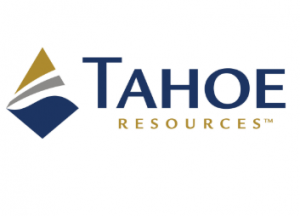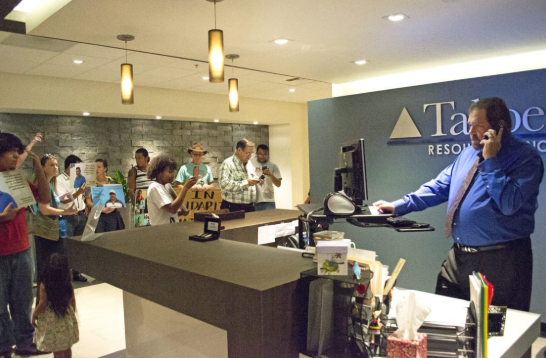Tahoe Resources president and COO Ron Clayton recently received the Cambridge House 2014 Silver Baron Award, which embodies 365 days of hard work and perseverance in the mining space, especially within silver.
“We are very pleased to present the 2014 to Mr. Clayton who has spent most of his career working for the betterment of the industry,” said Jay Marton, Cambridge House president.
The 56-year-old Clayton is a silver miner to his very core beginning with his first job working for Homestake Mining in the Bulldog silver mine in Creede, Colorado.
Growing up in Alamosa, Colorado, Clayton delivered auto parts for his father part-time during high school. One delivery was to a perlite mine in Antonito, Colorado. Bob Drips, who was running the perlite mine, had more of a background in silver and uranium mining in New Mexico, and got Clayton interested in mining.
As a result, Clayton said he pestered the Bulldog people in Creede, Colorado until eventually he got his first job.
“I love it. I love the people. I love being underground,” Clayton said during an interview on Friday with Mineweb. “Sometimes I get to the point where I’ve been away too long and want to get underground.
“I think that’s what’s missing in our world today. There are a lot of very narrow-vein deposits out there, really narrow stuff, that the talent and skill to mine those things is going away,” he suggested.
“I started out about as low as you can get on the totem pole. I was a supplier hauler and I cleaned out the honey buckets,” he recalled.

Since that first job, Clayton graduated from the Colorado School of Mines with a B.S. in Mining Engineering, held a number of engineering and operations positions with Homestake and the Climax Molybdenum Company, eventually becoming senior vice president of operations for Hecla Mining Company. The result was 30 years of operating experience, primarily in silver mining.
In 2010, Clayton joined Tahoe Resources (THO), which has an operations office in Reno, commenced commercial production at the Escobal mine in Guatemala about a year ago and plans this year to produce at least 20 million ounces of silver at a total cash cost of $5.65-$6.25/oz and all-in sustaining costs of $8.85-$9.85/oz net of by-product credit.
When asked what changes he has seen thus far in his three-decades of mining, Clayton observed, “The transitions that I’ve seen probably run more to the demands of the deposit than they are to modernization, really.”
“If you think about the processing part of it – we’re still using pretty old, standard technology. The pieces of equipment are newer and more modern. And they’re controlled by computers. But we still crush it, grind it and float it; depress the zinc and float the lead and hope all the silver goes with the lead.”
Silver price
“The biggest difference is, obviously, the silver price and that’s being driven by the change in the way silver is being used,” Clayton observed. “You think back about how many years we spent trying to make money at $5, $6, $7 silver, you have to go clear back to when the Hunt Brothers did their thing.
“It’s not an easy business, being in the primary silver business,” Clayton observed. “There’s an awful lot of by-product silver out there, that’s always going to have some pressure down on the price.”
Nelson Bunker Hunt and his brother William Herbert Hunt attempted to corner the silver market, causing a panic in financial markets in general, as well as commodities and futures, on March 27 1980, as the Hunts lost over a billion dollars in the incident.
“The point is that there were some companies even back then that could make a profit at $7 silver, including Homestake’s Bulldog mine in Creede and the Lucky Friday in Idaho in its heyday,” according to Clayton.
“Today the cost profile has gone up enough, I was looking yesterday at something BMO put out where a lot of the primary silver producers’ all-in costs right now are higher than the spot price,” he said.
“The demand for silver has gone up because we’re not relying on photography any more. It’s more electronics, cell phones, that kind of thing,” he observed. “The real difference that it makes at the end of the day is a foundation on the bottom. I don’t think that physical demand really drives price, I think it’s investment.
“I am a real believer that silver is still an investment vehicle and that’s what creates the pricing and the new industrial uses are keeping the floor up a little higher,” Clayton stressed.
“My philosophy is an awful lot like Kevin’s [Tahoe Resources CEO Kevin McArthur]. We’re precious metals miners. We both strongly believe that the silver and gold prices are more related to the real value of a dollar, which is constantly going down; so it takes more ounces of silver to make a dollar all the time.”
“Maybe it’s a year out, maybe it’s two, things are going to change as they always do and the prices will go up relative to the dollar.
“When gold’s coming down, it (silver) will beat it to the bottom, and when gold starts up, silver is going to close the gap. I have seen it happen every time,” he observed.
Tahoe Resources began as a public company with a C$6 share price, which is now trading at $20-22/sh.
“It’s (Escobal) a hell of a deposit,” Clayton observed. “It has a really good team. Frankly, we’ve done everything we told people we were doing in Guatemala. Out of the mine’s roughly 900 employees, only 25 are not Guatemalans. Most of them had never been in a mine before.
“Right now our miners, between their safety and productivity, are as good as miners anywhere in the world,” he noted. “Sometimes, it’s really good to take farmers and teach them how to be miners and millers.”
A number of the employees in Escobar’s metallurgy and processing are women. “Women can’t work underground in Guatemala, it’s the law. So the way we get around that law is that geologists don’t work underground all day,” he added.
Social license to operate
Located on the outskirts of San Rafael las Flores, Escobal operates in an area where a large number of families survive on subsistence farming. Local communities started organizing protests against the mine in 2011.
Clayton told Mineweb that the bulk of anti-mining activity occurred between September 2012 and April 2013, and that Escobar hasn’t had a single protest since April 2013.
“There’s a lot of money coming into the country that’s anti-mining development,” Clayton said. “It’s always going to be a lot of noise.”
On May 2, 2013, Guatemala’s president declared a state of siege around the Escobal “to quell criminal gangs,” the BBC News reported in June of this year. “Thousands of troops were deployed, constitutional rights were suspended and scores of anti-mining activists arrested.”
Nevertheless, Clayton insists Escobal has made considerable progress in securing mining’s social license to operate in San Rafael las Flores.
“In my opinion, what it takes to get through that is you have to do what you said you are going to do; and you have to follow through and do that day in and day out, as consistently and persistently as you can. People will eventually come around to the idea that progress is a good thing,” he said.

Clayton said he is “really proud” that many of the small children, who used to work with their parents in the field, are now wearing clean clothes and going to school. “So there is more money in the area,” he noted. “People can afford to hire help to go out into the fields. They can afford to buy clean clothes and send their kids to school.
“I get slightly testy when I hear people complaining about the people from Central America that are coming into this country illegally,” Clayton remarked. “They’re coming up here not because they want to live here, but because they’re oppressed. Part of that is there’s no rule of law, which we could much more cost effectively help with down there than deal with the problem up here. Part of that would be if governments would just help countries like that develop the rule of law and help them attract foreign investment into the country.”
Tahoe Resources is now the largest taxpayer in the country. “Once you got us in there, we’re more than willing to be good neighbors. We have people moving back from the US to San Rafael las Flores because they can get a good job now. They can feed their kids. It’s a relative area of safety. It’s one of the things I am really proud of,” he stressed.
During Clayton’s tenure with Hecla Mining, the company sold its Isidora gold mine in Venezuela to Rusoro Mining as the Chavez Administration expropriated foreign-owned businesses in the country.
“Actually Venezuela was lot more difficult to deal with,” Clayton recalled. “The reason it was because we get strong support from the community and the government (in Guatemala) and we never got that in Venezuela.”
Guatemala is a democracy with a single house legislature. The country’s President Otto Perez Molina, the former head of the nation’s army, is supportive of Escobal, Clayton asserted, adding that Perez has been very good about trying to minimize corruption in Guatemala.
“This president still views us as a model for attracting investment into the country,” said Clayton, adding that Escobal officials talk to oil and gas, railroad companies, and maquiladora clothing manufacturing companies.
“I like doing business in Guatemala. It’s a good place to do business,” he added.






































